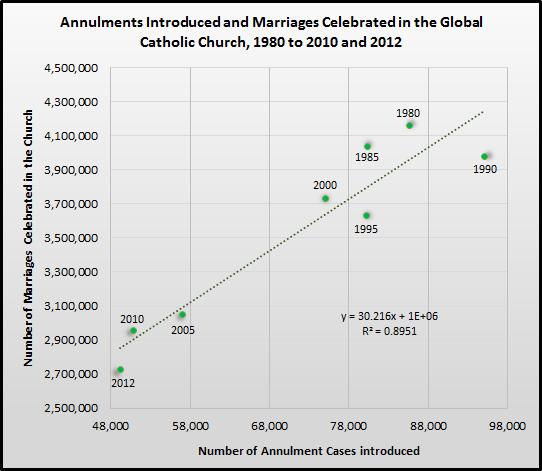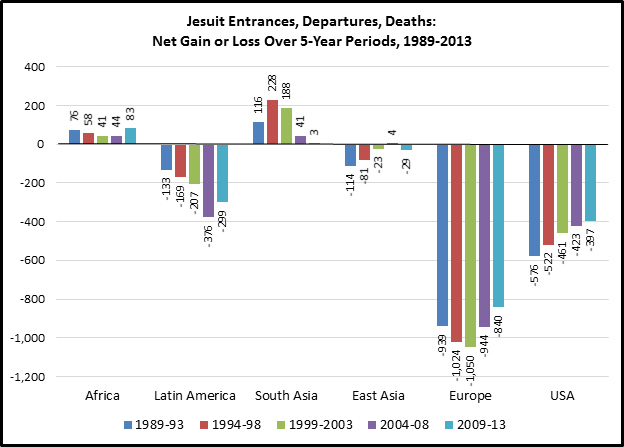Social scientists often focus on the share of people who believe in God as a barometer for religiosity. Yet, for salvation religions, a belief in the afterlife is also centrally important. What may be surprising to some is that significantly sized segments of Christians—including Catholics—believe in God but not in heaven and even fewer in hell. For someone who does not believe in an afterlife what does it matter if they only go to Mass on Christmas and Easter? How does sin matter at all? What is a saint?
The table below shows results from the Pew Research Center’s most recent Religious Landscape Survey (2014). Among those self-identifying as Catholic, 97% say they believe in God but only 85% believe in heaven and 63% in hell. Similar “gaps” in belief are evident among Protestants, Mormons, Orthodox Christians, and Muslim Americans. Surprisingly, even nearly half of agnostics say they believe in God (46%) yet only 14% believe in heaven and 9% in hell.
Oddly, if one looks at polling data from a historical perspective and among the total population belief in the afterlife, both heaven and hell, steadily increased from the 1950s to the 2000s. In only the last few years has belief in both begun to dip again. Still, more Americans believe in an afterlife now than they did decades ago (…another empirical reflection of the 1950s being no “golden age” for religion).
There is one caveat to the data presented above. Even fewer Americans believe in heaven and hell if you try to describe those two places. For example, estimates of belief fall a bit when Pew describes hell as a place “where people who have led bad lives and die without being sorry are eternally punished.” Perhaps some feel hell isn’t this bad?
The Catholic Church, like Pew’s question writers, is pretty clear in its description of hell. According to the Catechism, “The teaching of the Church affirms the existence of hell and its eternity. Immediately after death the souls of those who die in a state of mortal sin descend into hell, where they suffer the punishments of hell, ‘eternal fire.’”
By contrast, the Church teaches that, “The perfect life with the Most Holy Trinity—this communion of life and love with the Trinity, with the Virgin Mary, the angels, and all the blessed—is called ‘heaven.’” Further the Church describes, “This mystery of blessed communion with God and all who are in Christ is beyond all understanding and description. Scripture speaks of it in images: life, light, peace, wedding feast, wine of the kingdom, the Father’s house, the heavenly Jerusalem, paradise.” And then of course there is purgatory. This is described by the Church as a place for those who “die in God’s grace and friendship, but still imperfectly purified.”
There is one survey from 2010 that I could locate and study that combined the three possibilities of heaven, purgatory, or hell into one response. As shown below, nearly three in four Catholic adults agreed that these destinations are most likely where people go after dying (73%). Evangelical Christians were more likely to agree (91%) and those with no religious affiliation (aggregating “Nones,” agnostics, and atheists) were least likely to do so (27%).
One of the few things Americans agree on, regardless of religious affiliation, is that we don’t “become ghosts” after we die. This is also somewhat odd as Gallup surveys indicate about 40% of American adults believe in ghosts! Maybe this is state of being only reserved for a few unlucky souls?
A CBS News survey from 2014 asked American adults who believed in heaven and hell (77% of their respondents), “At the end of your life, where do you think you are most likely to wind up—in heaven or in hell or neither one?” Eighty-two percent believe they are going to heaven and only 2% believe they are going to hell (16% said “neither” or they didn’t know). In 2012, a 60 Minutes/Vanity Fair poll asked respondents, “Assuming they both exist, which do you think is more important for the human race—Heaven, to reward the good, or Hell, to punish the evil?” Eighty percent said we need heaven more than hell. Ten percent chose hell, 4% said we need both equally and 5% didn’t know.
Perhaps the best indicator of the future of belief in heaven and hell among U.S. Catholics is to look at what young Catholic parents believe today. After all their beliefs are likely to be passed on to their children. CARA recently surveyed self-identified Catholics, ages 25 to 45, who are currently parents to minor children. As shown below, about two-thirds believe in heaven and hell without doubt (65%). About one in ten believes in heaven without doubt but has doubts about or does not believe in hell (11%). Nearly a quarter have doubts about or do not believe in both heaven and hell (23%).
Although belief in heaven and hell now exceeds levels of belief of the more distant past, there is still this puzzling gap between American’s belief in God and their belief about what happens after life. We have examined before how this is correlated with frequency of Mass attendance and confession among Catholics. The lack of belief in an afterlife among some Catholics may represent a “soft” form of secularization—a segment that may be more likely to leave the faith in the future. A majority of Americans who do not believe in an afterlife have no religious affiliation (54%).
One final piece of data. The General Social Survey has been asking a more generic afterlife question since the early 1970s. Rather than asking about heaven or hell or trying to describe these, it simply inquires, “Do you believe there is a life after death?” Here we can see something interesting. Among all religiously affiliated American adults who are not Catholic, belief in life after death is increasing slightly over time. Yet, among Catholics, the trend line has been sloping downward since 2010. Religiously unaffiliated adults are also losing belief in an afterlife.
Seventeenth century mathematician Blaise Pascal put the afterlife at the center of his “wager” and argument for belief in God. With eternal paradise or punishment on the line it makes sense to live a good life now given the inevitability of death. A rational person would have to be absolutely sure hell was not an option to do otherwise. If he were alive today I think Pascal would be puzzled by the number of American Christians who believe in God but not an afterlife. He’d also likely wonder a bit about the atheists and agnostics who believe in heaven. But then again, being dead he has already seen the payoff to his wager.
Image courtesy of peppergrasss.









































